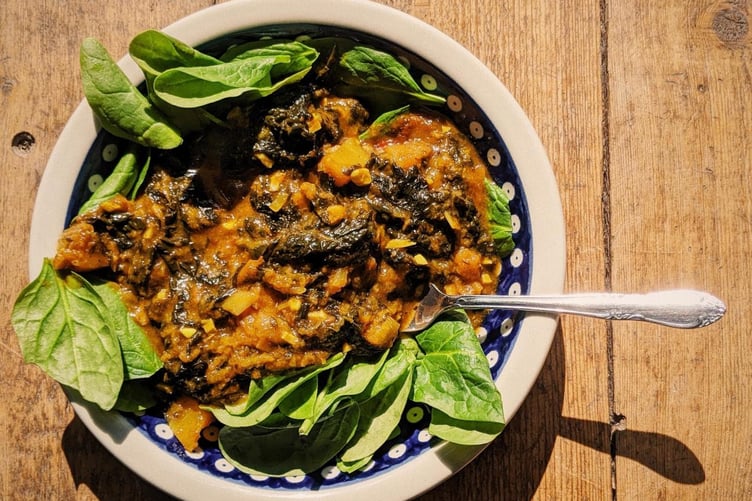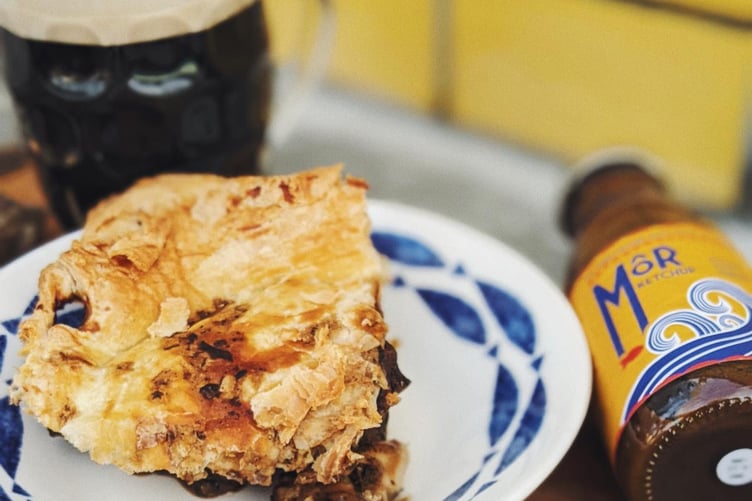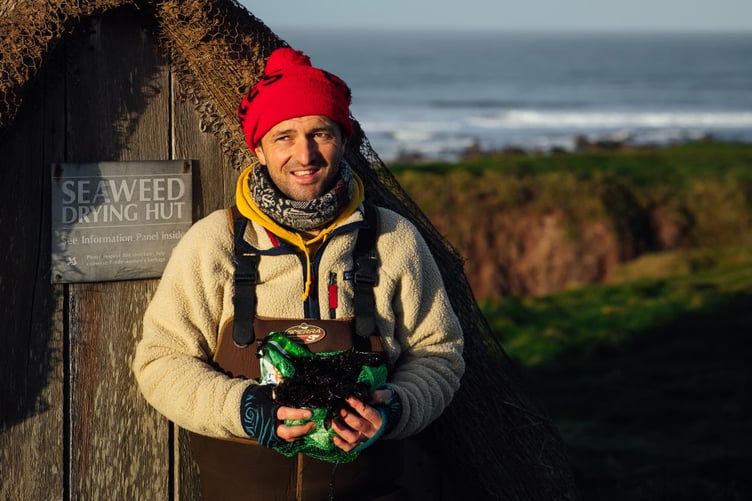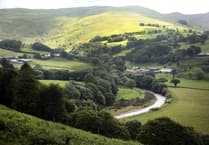The second ever National Laverbread Day takes place tomorrow (Friday, April 14). Founded in Pembrokeshire, the national day was launched in 2022 to celebrate laverbread – a Welsh delicacy made by cooking porphyra seaweed for many hours.
Laverbread is a traditional part of a Welsh breakfast, but it has many other uses. These days you’ll find it in biscuits, breads, sauces and seasoning – and many high-end chefs make creative use of its distinctive umami flavour.
National Laverbread Day was created by Jonathan Williams, founder of the Pembrokeshire Seafood Company, which is based in Pembrokeshire, West Wales. The company produces laverbread and laverbread-based foods, and also runs Café Môr, a multi-award-winning street food outlet that now has a permanent base at The Old Point House, the pub at Angle, Pembrokeshire that the Pembrokeshire Beach Food Company took over in 2022.
Laverbread Day will see a whole host of events taking place at The Old Point House, including laverbread tasting, live music, a laverbread eating competition and a laverbread history exhibition.
Other pubs, chefs, delicatessens and food-focussed businesses are invited to get involved.
“We have chosen April 14 as National Laverbread Day because it’s the same day the Japanese celebrate ‘Mother of the Sea Day’ in honour of Kathleen Mary Drew-Baker, whose research into the cultivation of porphyra seaweed led to a commercial breakthrough for the Japanese Nori (laver) industry,” says Jonathan.
“Last year’s inaugural event was a great success – The Old Point House welcomed hundreds of visitors, including a male voice choir, and Café Môr did a roaring trade in its famous laverbread-based street food. Other businesses across the country held laverbread-themed events too, putting laverbread on the menu for the day.”
Jonathan hopes this year’s National Laverbread Day will be even bigger and better.
“Laverbread is a delicious, interesting, and underused ingredient, and the aim of National Laverbread Day is to encourage people to try eating and cooking with it. In terms of sustainability credentials, it’s the food of the future – and it’s also packed with nutrients.
“We’re encouraging people to try cooking with laverbread at home and share their pictures with the hashtag #Nationallaverbreadday.”
Anyone wanting to hold their own event can email [email protected]
Scroll down for laverbread recipes and laverbread facts.
10 facts about laverbread
- Despite its name, laverbread does not contain any bread or grains, nor does it resemble bread.
- Laverbread is cooked laver, a type of seaweed that grows around much of the UKs coastline, but is almost exclusively harvested from the rocky shores of the Welsh coast. It keeps people who harvest it on their toes by forever changing its mind about where and when it grows.
- Laverbread is a dark green, almost black paste that is often compared to a thick puree or pâté.
- To make laverbread, the laver is boiled until it becomes soft and then pureed with a little water. Few foods take as long as laverbread to cook (typically eight hours).
- Laverbread is rich in vitamins and minerals. Gram for gram it contains more protein than chicken. It’s particularly high in Vitamin A, B2, B9, and C and contains 10 times as much vitamin A as spinach and four times as much vitamin C as apples.
- It has been dubbed ‘future food’ because it requires no land, fresh water, pesticides or fertilisers and can grow 5mm a day.
- Laverbread is a traditional Welsh food that has been eaten for centuries. It’s often served as a breakfast dish with bacon, cockles, and fried bread. Sometimes it’s simply heated and served alongside the other ingredients; other times it’s mixed with oats to make patties, which are then fried in the bacon fat.
- Laverbread can also be used as an ingredient in other dishes, such as soups, stews, and sushi.
- Laverbread has a distinctive umami flavour – many people say it tastes of the sea.
- Laver has one of the strangest and most complicated lifecycles: it can be both male and female, and at one stage of its life it is neither. You could call it the original non-binary lifeform.
Recipes

Butternut, Laverbread and Coconut Curry
Serves 4
Preparation Time: 10 minutes
Cooking Time: 10 minutes
A hugely satisfying vegetarian curry best served with onion salad, mango chutney and lime pickles.
Ingredients
- 150g grated cauliflower
- 1 tbsp coconut oil
- 1 butternut squash, diced
- 1 red onion, diced
- 1 red chilli diced
- 4 garlic cloves diced
- 1 inch stick of ginger diced
- 2 tbsp mild curry paste
- 1 can of coconut milk
- 150ml of vegetable stock
- 4 large tomatoes, roughly chopped
- 120g of laverbread
- 3 tbsp fat-free Greek yogurt
- Small handful coriander, chopped
- Large handful of chopped spinach
- Salt and pepper
Directions
- Heat the oil in a large pan on a medium heat.
- Add the onions and cook until caramelised.
- Add the ginger, chilli, garlic and butternut squash. Cool for around 5 minutes
- Add the curry paste, veggie stock, tomatoes, laverbread and coconut milk, and simmer for 10 mins until thickened to a rich sauce.
- Add grated cauliflower and simmer for another 2 mins. Season with salt and pepper
- Serve warm with chutneys, and maybe even a naan.

Beef and Oyster Pie with laverbread, Guinness and Môr Ketchup gravy
Serves 6-8
Preparation Time: 1 hour 30 minutes
Cooking Time: 35 minutes
An instant classic that deserves to be showcased and is well worth the effort. A sublime mix of beef, laverbread, oysters and Guinness or Seaweed Beer!
Serve with the finest chips and peas or creamy mash potato and smoky beans.
Ingredients
- 1kg beef stewing meat – diced
- 35 g plain flour
- 5 tablespoons olive oil
- 225g mushrooms, trimmed
- 3 shallots, thinly sliced
- 1 teaspoon brown sugar
- 300 ml Guinness or Trawlers Dread
- 300 ml beef stock
- 2 tbsp of Laverbread
- 2 tbsp of Môr Ketchup
- A sprinkle of thyme
- 2 bay leaves
- 1 tbsp of Captain Cats Môr Seasoning
- 1 tablespoon Worcestershire sauce
- Sea salt and freshly ground black pepper
- 12 native or pacific oysters (optional- you can choose to leave them out and enjoy a wonderful beef and ale pie alternative! )
- 450 g puff pastry
- 1 small egg, beaten, for brushing
Directions
- Season the pieces of diced steak and mix with the flour and shake off, but reserve the excess flour.
- Heat 3 tablespoons of the oil in a flameproof casserole or large saucepan and brown the meat in two batches until well coloured on all sides.
- Transfer to a plate. Add another tablespoon of the oil, half the butter and the mushrooms to the pan and fry briefly.
- Set aside with the beef. Add the rest of the oil and butter, the onions and sugar to the pan and fry over a medium heat for 20 minutes, until the onions are nicely browned. Stir in the reserved flour, then gradually add the Guinness or beer and the stock and bring to a simmer. Stir occasionally.
- Add the laverbread , Môr Ketchup, Worcestershire sauce, Captain Cats seasoning and then return the beef and mushrooms to the pan with the herbs and any other seasonings and add salt and pepper to taste.
- Cover and simmer until the meat is just tender. For around 1 hour.
- Lift the meat, mushrooms and onions out of the gravy with a slotted spoon and put into a deep pie dish.
- Bring the gravy to the boil and reduce until thickened.
- Remove the bay leaves and thyme and check seasoning and adjust to taste.
- Pour into pie dish and stir and let cool
- Preheat the oven to 200˚ C.
- Now shuck the oysters and place them into the pie dish with the cooked and cooled pie mix.
- Roll out the pastry on a lightly floured surface until it is 2.5 cm larger than the top of the pie dish.
- Cut off a thin strip from around the edge, brush it with a little beaten egg and press it on to the rim of the dish.
- Brush the seal with more egg, and cut a small cross into the centre of the pie.
- Press the edges together well to seal.
- Trim away the excess overhanging pastry and crimp the edges between your fingers to give an attractive finish.
- Chill in the fridge for 20 minutes to relax the pastry.
- Brush the top of the pie with the beaten egg and bake for 30 to 35 minutes, until the pastry is crisp and golden and the filling is bubbling hot.


.jpeg?width=209&height=140&crop=209:145,smart&quality=75)


Comments
This article has no comments yet. Be the first to leave a comment.